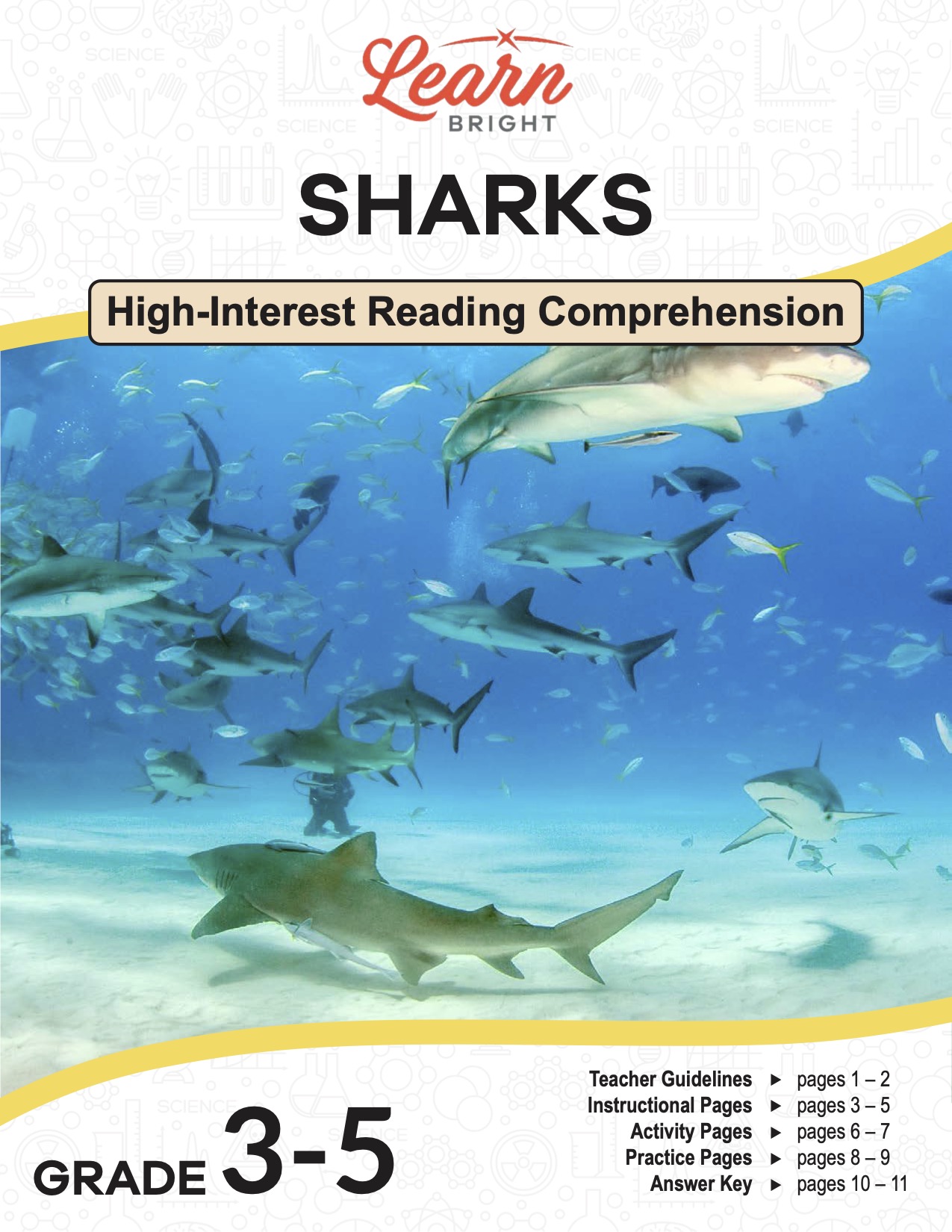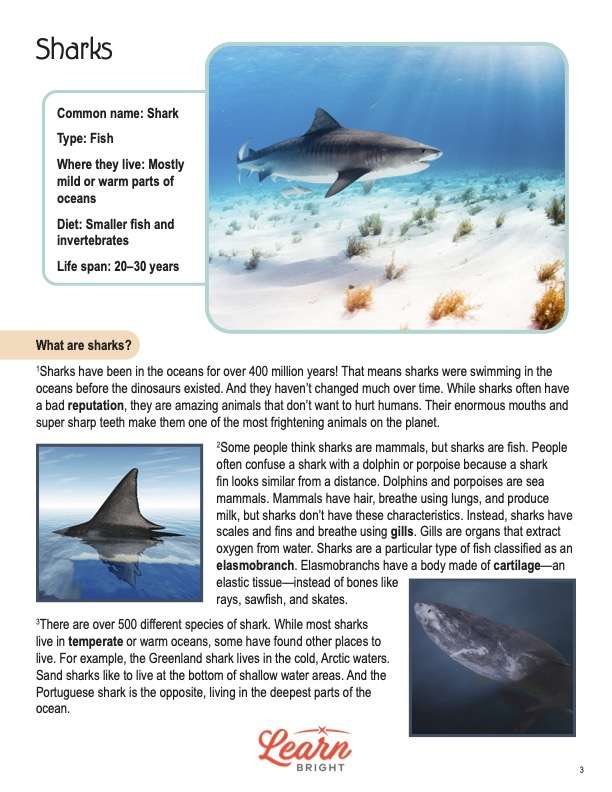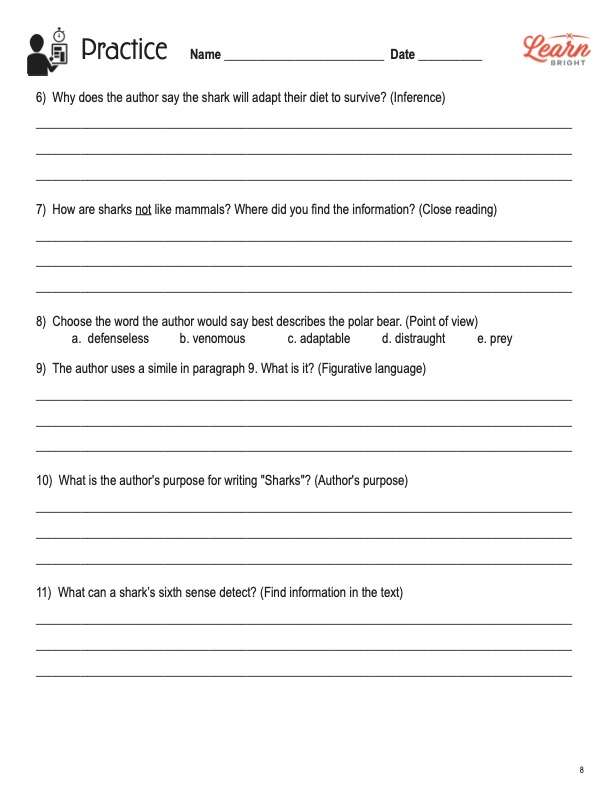Description
What our Sharks lesson plan includes
Lesson Objectives and Overview: Sharks is a high-interest reading comprehension lesson plan. As such, students will practice various close reading and comprehension skills. In addition, they will learn about sharks’ habitat, diet, and behaviors. This lesson is for students in 3rd grade, 4th grade, and 5th grade.
Classroom Procedure
Every lesson plan provides you with a classroom procedure page that outlines a step-by-step guide to follow. You do not have to follow the guide exactly. The guide helps you organize the lesson and details when to hand out worksheets. It also lists information in the yellow box that you might find useful. You will find the lesson objectives, state standards, and number of class sessions the lesson should take to complete in this area. In addition, it describes the supplies you will need as well as what and how you need to prepare beforehand.
Teacher Notes
The teacher notes page provides an extra paragraph of information to help guide the lesson. It explains that you can teach this lesson in a whole-class setting or to an independent, small group as an activity. You can use the blank lines to write down any other ideas or thoughts you have about the topic as you prepare.
SHARKS LESSON PLAN CONTENT PAGES
What Is a Shark?
The Sharks lesson plan contains three content pages. It begins by providing a box of background information about this animal. Sharks are a type of a fish that live mostly in warm and mild parts of the ocean. Their diets typically include smaller fish and invertebrates. These incredible creatures usually live between 20 and 30 years.
Sharks have been in the oceans for over 400 million years! That means sharks were swimming in the oceans before the dinosaurs existed. They haven’t changed much over time. While sharks often have a bad reputation, they are amazing animals that don’t want to hurt humans. Their enormous mouths and super sharp teeth make them one of the most frightening animals on the planet.
Some people think sharks are mammals, but sharks are fish. People often confuse a shark with a dolphin or porpoise because a shark fin looks similar from a distance. Dolphins and porpoises are sea mammals. Mammals have hair, breathe using lungs, and produce milk, but sharks don’t have these characteristics. Instead, sharks have scales and fins and breathe using gills. Gills are organs that extract oxygen from water. Sharks are a particular type of fish classified as an elasmobranch. Elasmobranchs have a body made of cartilage—an elastic tissue—instead of bones like rays, sawfish, and skates.
There are over 500 different species of shark. While most sharks live in temperate or warm oceans, some have found other places to live. For example, the Greenland shark lives in the cold, Arctic waters. Sand sharks like to live at the bottom of shallow water areas. And the Portuguese shark is the opposite, living in the deepest parts of the ocean.
What Sharks Eat
Sharks come in all sizes and colors. The whale shark is the largest living fish, reaching 50 feet long and weighing about 20 tons. The dwarf lantern shark is the smallest and is only about 71⁄2 inches long. But all sharks have the same basic shape. They usually have grey skin but can also be cream, yellow, bronze, blue, or almost black with bands, spots, or marble patterns. Most have a pointed snout that extends over their mouth. But the hammerhead shark, of course, has a broad flat head! Sharks’ teeth are sharp and triangular and grow throughout their lives. They also all have pointed fins and muscular, upturned tails.
The lesson explains that there are as many different eating habits as there are sharks. Most sharks are carnivores and very efficient predators. They eat fish, mollusks, and crustaceans. Large sharks will also eat dolphins, seals, sea lions, tuna, and mackerel. But some like to eat seabirds and even plankton! Tiger sharks prefer turtles while blue sharks enjoy squid. What they eat and what is available depends on where the sharks live. Different types of prey live in other parts of the ocean.
Sharks adapt their diet to survive. This means that while they like to eat certain types of prey, they will eat something else if their favorite meal is unavailable. Sharks aren’t picky! Some sharks have been known to consume oil, trash, and clothes that find their way into the oceans.
Carnivorous sharks use multiple strategies to catch prey. Some shark species swallow their prey whole, while others tear off chunks in large bites. Thresher sharks stun their prey with their tail, and saw sharks twist their prey inside the sand. The sharks that live on the ocean floor ambush their prey, which means they surprise attack from a concealed position. Others use camouflage to hunt prey.
Interesting Facts and Why Sharks Are Important
The next section gives students a few fun facts about sharks. For instance, all sharks have a sixth sense that helps them hone in on their prey. In addition, sharks have sense organs that can detect electric fields. They are called ampullae of lorenzini and are found on a shark’s snout. During the final phase of an attack, the shark can sense the electric fields emitted (given off) by animals in the surrounding water.
Sharks constantly swim to keep from sinking like an anchor. This means they can’t take time off to sleep. Instead, sharks have periods of activity or rest. When they are active, most sharks can swim 20 to 30 miles per hour. Most sharks live alone, but some, like the spiny dogfish, will form schools or groups.
Students will discover that, just like other apex predators, sharks are important to the environment because they help keep the food chain in balance. They eat weak and sick fish, and their feeding can directly affect prey population numbers. Tiger sharks eat green turtles, which helps to ensure the turtles don’t over-graze the grass.
The demand for fins, overfishing, and human disturbance threaten shark populations. It is important not to eat shark fin soup and to know which fish species you purchase at the market. A quarter of the world’s shark species are currently threatened with extinction, as over 100 million sharks are killed each year by fisheries alone! In addition, climate change is forcing sharks to move to waters they are not familiar with. Though climate change dramatically affects the shark habitat and behavior, commercial fishing remains the greatest threat to the shark population.
SHARK LESSON PLAN WORKSHEETS
The Sharks lesson plan includes two worksheets: an activity worksheet and a practice worksheet. Each one will help students solidify their grasp of the material they learned throughout the lesson. You can refer to the classroom procedure guidelines to know when to hand out each worksheet.
SHORT STORY ACTIVITY WORKSHEET
For the activity, students will choose a shark species to write about. Using the template on the worksheet, they will write a story about their chosen species from the shark’s point of view. They must include facts about the shark’s habitat and diet as well. Students can share their stories with the class once everyone finishes.
SHARKS PRACTICE WORKSHEET
The practice worksheet requires students to answer a series of 11 questions. These questions all relate to the content pages, so students will need to refer to them often for the answers. In addition, each question provides which reading tool the question corresponds to, such as text feature, vocabulary, or comprehension.
Worksheet Answer Keys
At the end of the lesson plan document is an answer key for the practice worksheet. The correct answers are all in red to make it easier for you to compare them with students’ responses. If you choose to administer the lesson pages to your students via PDF, you will need to save a new file that omits these pages. Otherwise, you can simply print out the applicable pages and keep these as reference for yourself when grading assignments.









